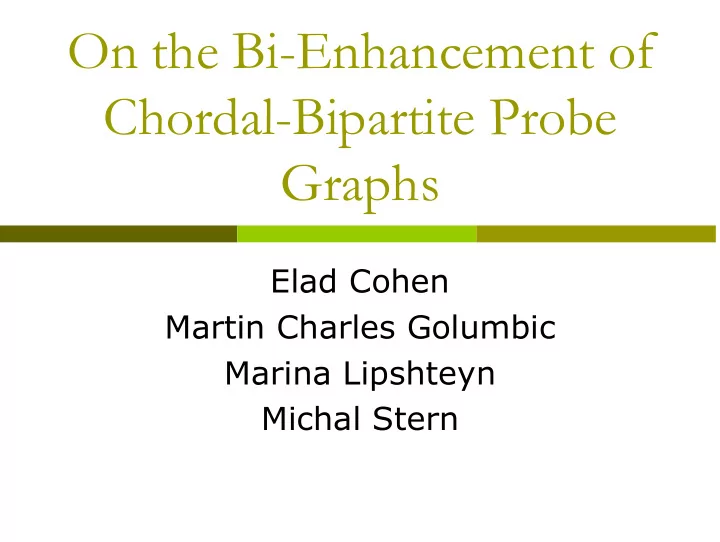

On the Bi-Enhancement of Chordal-Bipartite Probe Graphs Elad Cohen Martin Charles Golumbic Marina Lipshteyn Michal Stern
Outline � Definitions � C -probe problem � Previous work � C -probe graphs: � Chordal probe � Chordal-bipartite probe � Open questions
Definitions � C k – chordless cycle of size k. � Chordal graph – a graph with no induced C k , for k>3. � Chordal-bipartite graph – a bipartite graph that has no induced C k , for k>4. � Interval graph is the intersection graph of a set of intervals on the real line.
The C -probe problem Let C be a graph family. � A graph G=(V,E) is called C - probe if � ∃ partition V=P(probes) ∪ N(non-probes), N 1. is a stable set ∃ completion E ’ ⊆ {(u,v)|u,v ∈ N} 2. such that G ’ =(V,E ∪ E ’ ) is in C . (Clearly G P is in C ) In the partitioned version the partition � into probes and non-probes is given and fixed.
The C -probe problem - example � Let C be the chordal graphs family. P- N-
Previous work � “ Probe interval graphs and their application to physical mapping of DNA ” [Zhang, 1994] � “ Chordal probe graphs ” [Golumbic, Lipshteyn, 2004] � “ Cycle-bicolorable graphs and triangulating chordal probe graphs ” [Berry, Golumbic, Lipshteyn, 2007]
Chordal probe – a necessary condition � Lemma 1 – If G is a chordal probe graph with respect to the partition P ∪ N, then probes and non-probes must alternate on every chordless cycle. P - N - Edges of a chordal completion -
Chordal probe - C 4 case The C 4 graph is a special case of chordal probe � graphs where it has: 1. Alternating probe/non-probe vertices. 2. An edge is forced between the two non-probe vertices, called an enhanced edge, for the C 4 a b to be completed into chordal graph. P - Enhanced N - edge - d c Let G be a graph, the enhanced graph G* is the � graph G together with all the enhanced edges.
Chordal probe - C 4 enhancing � Let G be a graph containing no induced chordless cycles C k , for k>4: Lemma 2[GL04][Z94] – If G has a probe/non- probe partition in which probes and non-probes alternate on every chordless 4-cycle, then the enhanced graph G* is a chordal completion of G. � Theorem 3 – If G is a C k -free graph for k>4, then G is chordal probe ⇔ G* is chordal.
Chordal-bipartite probe graphs A graph G=(V,E) is called chordal � bipartite probe if ∃ partition V=P(probes) ∪ N(non-probes), N 1. is a stable set ∃ completion E ’ ⊆ {(u,v)|u,v ∈ N, u and v are 2. in different biparts} such that G ’ =(V,E ∪ E ’ ) is bipartite. Since G p is a chordal bipartite graph and N is a � stable set, clearly G is a bipartite graph. Since there is only one bipartition, we keep the same bipartition by adding edge only between vertices from different biparts.
Chordal-bipartite probe – a necessary condition Lemma 4 [BCGLPSS07] – In every induced C k , � for k ≥ 6, of a chordal-bipartite probe graph the following properties must hold: Every probe sees at most one other probe. 1. There is at least one edge of the cycle whose endpoints 2. are probes. No possible completion into chordal-bipartite P - N - Bipartition vertices –
Chordal-bipartite probe - C 6 case C 6 is a special case of chordal-bipartite probe � graphs where: 1. There are exactly two non-probes, one black and the other blue, opposite each other. 2. An edge is forced between the two non-probe vertices, called a bi-enhanced edge, for C 6 to be completed into P - a chordal-bipartite graph. N - Bi-enhanced Bipartition edge - vertices - Let B be a bipartite graph, the bi-enhanced graph B* is � the graph B together with all the bi-enhanced edges.
Chordal-bipartite probe - C 6 enhancing � Let B be a bipartite graph with no induced chordless cycles C k , for k >6: Lemma 5 – If B has a probe/non-probe partition in which there are exactly two non-probes opposite each other on every chordless 6-cycle, then the bi-enhanced graph B* is a chordal-bipartite completion of B . Proof: Suppose B* is not a chordal-bipartite graph. Then B* is bipartite graph that has a cycle of size > 4. Choose C’ to be such a cycle in with minimal number h of bi- enhanced edges.
Proof of Lemma 5 –cont. � h =0: C’ is a cycle of size >4 in G , a contradiction. � h>0: Let [x1,a,b,x2] be a chordless C’ path in B*, where a,b are probes x1 a The pair {a,b} is a bypass of the edge (x1,x2) if and only if a,b not on C’ and have no C other neighbors on C’. b x2 Claim 1: Every bi - enhanced edge on C’ has a bypass. Claim 2: a vertex can be in at most one bypass on C’.
Proof of Lemma 5 –cont. Case 1: no adjacent bypasses C’C’’ C’’ is a chordless cycle of size >4 in G
Proof of Lemma 5 –cont. Case 2: adjacent bypasses C’C’’ C’’ is a chordless cycle of size >4 in G
Chordal-bipartite probe - C 6 enhancing � Theorem 6 – If B is a bipartite C k -free graph for k>6, then B is chordal-bipartite probe ⇔ B* is chordal-bipartite.
Chordal-bipartite probe - example P - N - Bipartition – black/red vertices Bi-enhanced edge -
Open questions � Find necessary and sufficient conditions for completing C k into a chordal-bipartite graph, for k>6. � Does a chordal-bipartite probe graph have a vertex or edge elimination algorithm ? � Research the probe problem on other graph classes.
Recommend
More recommend